It is midsummer and insects are out, setting their sights for your garden. Here’s what you need to know.
As much as I love my vegetable garden, there are nasty little pests who like it just as much. Here is a list of some of the more common vegetable pests and some suggestions as to what to do.
Common Vegetable Pests
SQUASH BUGS
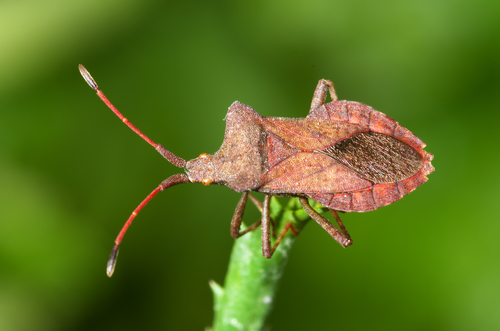
They are light to dark gray and look something like a stink bug. Stink bugs prefer tomatoes, however, so if you see insects that look like stink bugs on your squash plants, those insects are likely squash bugs. The best defense is to keep gardens free of weeds and debris. Trap by laying newspapers on the ground during the day. Squash bugs will congregate underneath where it’s shady and damp. During the early evening, you can toss the newspapers and the bugs go along for the ride.
Check leaves often for reddish-brown eggs laid in clusters of 10 to 15 and use sticky tape to remove them. Tansy, borage, radishes, and nasturtiums may help to repel them. If you choose to treat, Neem oil, pyrethrins, or Captain Jack’s Dead Bug Brew are effective—and organic. Be sure to apply very early morning or just before dark to avoid killing honeybees.
STINK BUGS
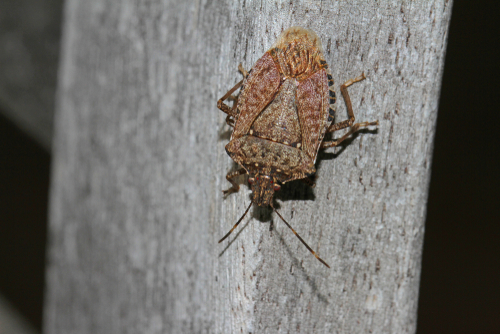
They resemble squash bugs but prefer tomatoes and fruits. Keep gardens free of weeds and debris. You can handpick or treat them as you would squash bugs.
CUCUMBER BEETLES
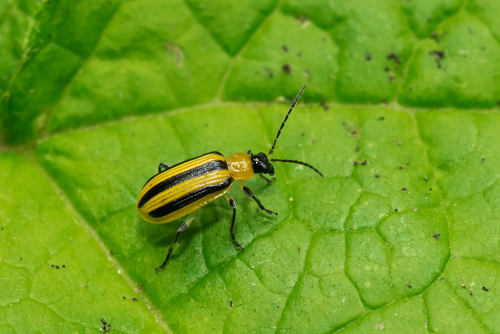
They are yellowish-green with dark stripes. They can spread diseases so inspect cucumbers often. Cucumber beetles hatch mid to end May. If you plant the first week of June, you can miss them altogether. Dipel is effective against the young or you can hand-pick. Radishes, rue, and tansy may repel them.
SQUASH VINE BORER
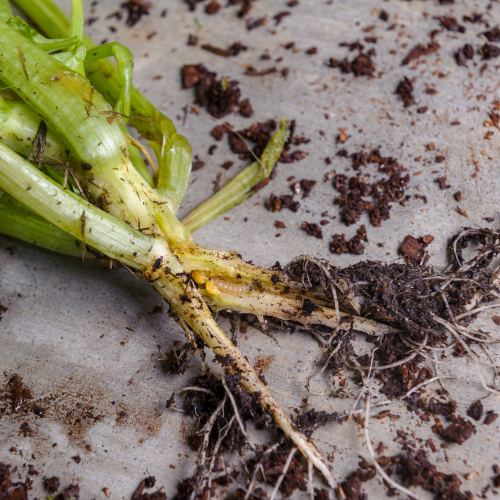
These are larvae that bore into stems, which then begin wilting at the tips. Spray stems with Dipel or insecticidal soap weekly (to kill any eggs that have been laid) or wrap the stems in strips of foil or muslin. If you had borers last year, plant squash in a different area this year—as the borers pupate underground over the winter and hatch late spring/early summer to lay eggs.
TOMATO HORNWORM
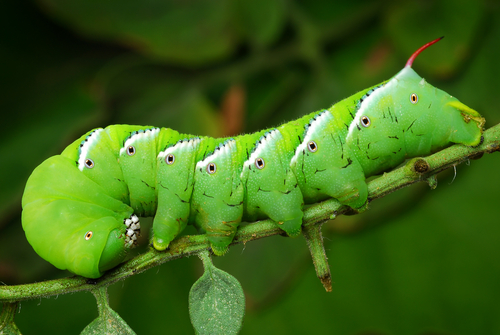
3 to 4” long green caterpillars that feed voraciously on tomato family members. The best control is to hand-pick, using gardening gloves (they can sting). If the caterpillars have little white ovals on their backs then just relocate to the bottom of the plant. These host the eggs to parasitic wasps that eat tomato hornworms. On the other hand, take the time to look up what a tomato hornworm turns into…I now plant an extra tomato and move the caterpillars to “their” plant.
CABBAGE WORMS/CABBAGE LOOPERS
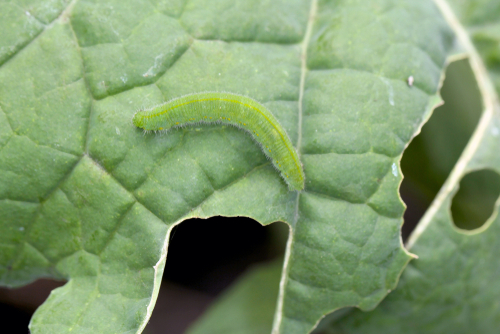
Both are caterpillars that prefer cabbage family members (broccoli, cauliflower, kale, cabbage). They are easily picked off. Check backs of leaves periodically and destroy eggs when you find them. Oregano, thyme, and mint may repel them. If an insecticide is necessary, Neem oil is very effective.
MEXICAN BEAN BEETLES
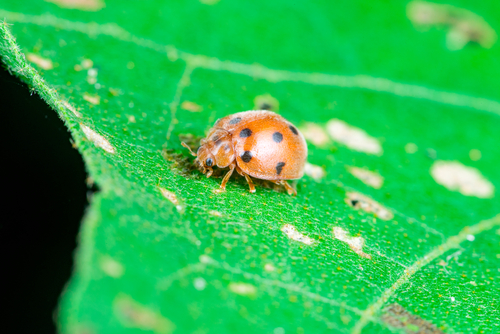
They resemble yellow/brown ladybugs (they are related). The larvae are yellow and spiny. Check backs of leaves for clusters of 20 to 30 yellow eggs. Handpick adults and use sticky tape to remove egg clusters. Neem oil is effective (remember to apply just before dark). Bush beans are less likely to get them.
APHIDS
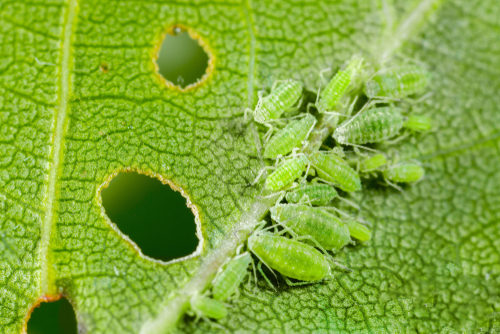
Aphids are small oval insects in assorted colors that congregate on new growth and/or flower buds. They can transmit diseases and are extremely prolific—they not only lay eggs but give birth to live young, too—and they’re born pregnant! Luckily, they can be easily washed off with a garden hose or can be treated with a mild organic pesticide. Garlic, onions, basil, and marigolds may repel them.
Take the Offense by Playing Defense
Remember—the best offense is a good defense. If you had insects last year, rotate crops this year. Keep gardens beds free of weeds and debris always. Check susceptible plants weekly, looking for foliage damage or eggs on the backs of leaves.
How to Use Organic Insecticides Properly
I tend to use hand-picking whenever possible. If I feel overwhelmed, I reach for Neem oil or Captain Jack’s Dead Bug Brew. Timing is really important. DO NOT spray during the day when bees and butterflies are about. They tend to go home about eight or eight-thirty at night so that’s when I spray.
Interestingly, that’s also when most of the bad guys come out to feed—they wait until almost dark when the birds have gone back to the nest. So spraying just before dark, you’ll not only get more of the bad guys, but you’ll give the good guys a chance to get the heck out of Dodge!
How to Handle Four-Legged Pests
If you’re having a problem with four-legged pests, like deer or squirrels, here are a couple of tips. For deer, plant herbs in and around your vegetable garden, Deer doesn’t like the strong fragrance of herbs—and some herbs may help to deter insect pests, too. And, of course, there are a number of effective deer repellents on the market. Stop by the Great Big Greenhouse and talk with one of our knowledgeable staff for recommendations based on your specific situation.
If squirrels are eating your green tomatoes, they’re looking for the moisture content (that’s why you find the tomato on the ground with one bite taken out of it). Spray green tomatoes with a repellent called Hot Pepper Wax. Then place an easily accessible water source 10 to 20 feet away—a birdbath—even a plastic saucer filled with water. You must do BOTH the spray and the water source. If we’re in a dry spell and the squirrel needs water, he’ll tolerate the pepper spray anyway. I have the best results when I do both.
Questions? We’re Here to Help!
If you’ve got a question or a problem about your summer garden, come in and see us!

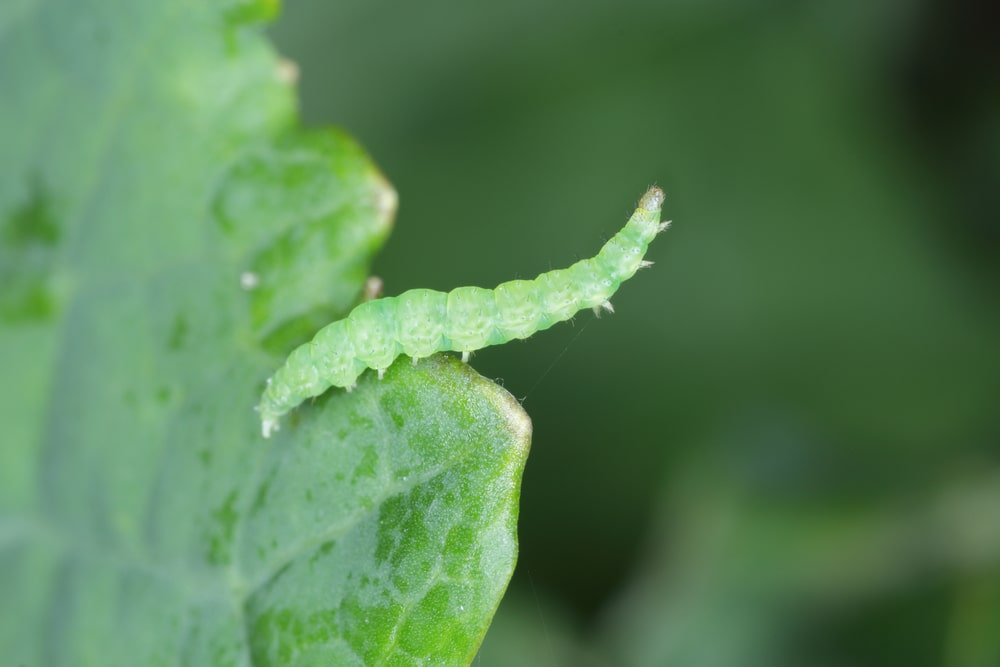
I just recently planted two basil plants (one purple) and they are being eaten “alive” esp. the green one. Holes in the leaves and can’t see the insect.
HELP!!
Lydia–basil is delicious and slugs, Japanese beetles and aphids think so, too. It’s most likely slugs–and you often don’t “see” them because they are active at night. If the leaves look somewhat “lacy” it might be Japanese beetles, because they don’t eat the veins of the leaves. I doubt it’s Japanese beetles because you’d most likely see them as they’re out during the day. Because slugs seem to be the number one fans of basil, that may be it. One thing you can do is get a product called diatomaceous earth and sprinkle it over the soil under the plant. Slugs won’t crawl over it. The other thing to do is, if the basil is in pots, get them up off the deck or patio onto a table or shelf, even sit them on top of a cinder block. That and the diatomaceous earth should take care of the problem.
Japanese beetles are attacking my hibiscus plant. I have picked them off and dropped them into a jar of rubbing alcohol. What can I use to keep them away?
Japanese beetle traps will help. The traps contain a “lure” to attract beetles so the trick is to put them AWAY from what they are eating…You’ll still have to pick some off but not as many.
What you are seeing on your tomatoes are stink bugs–they look similar to squash bugs but prefer tomatoes. To battle them, use Captain Jack’s Dead Bug Brew or Neem Oil. Check the plants every day or so. For squash bugs on squash, catch them early–they start showing up the very beginning of the summer. They lay eggs in convenient clusters on the backs of the leaves that can be “tapped” off with the stick side of duct tape. They like to winter over in garden debris so be sure to keep the area CLEAN over the winter. Consider rotating crops every couple of years.